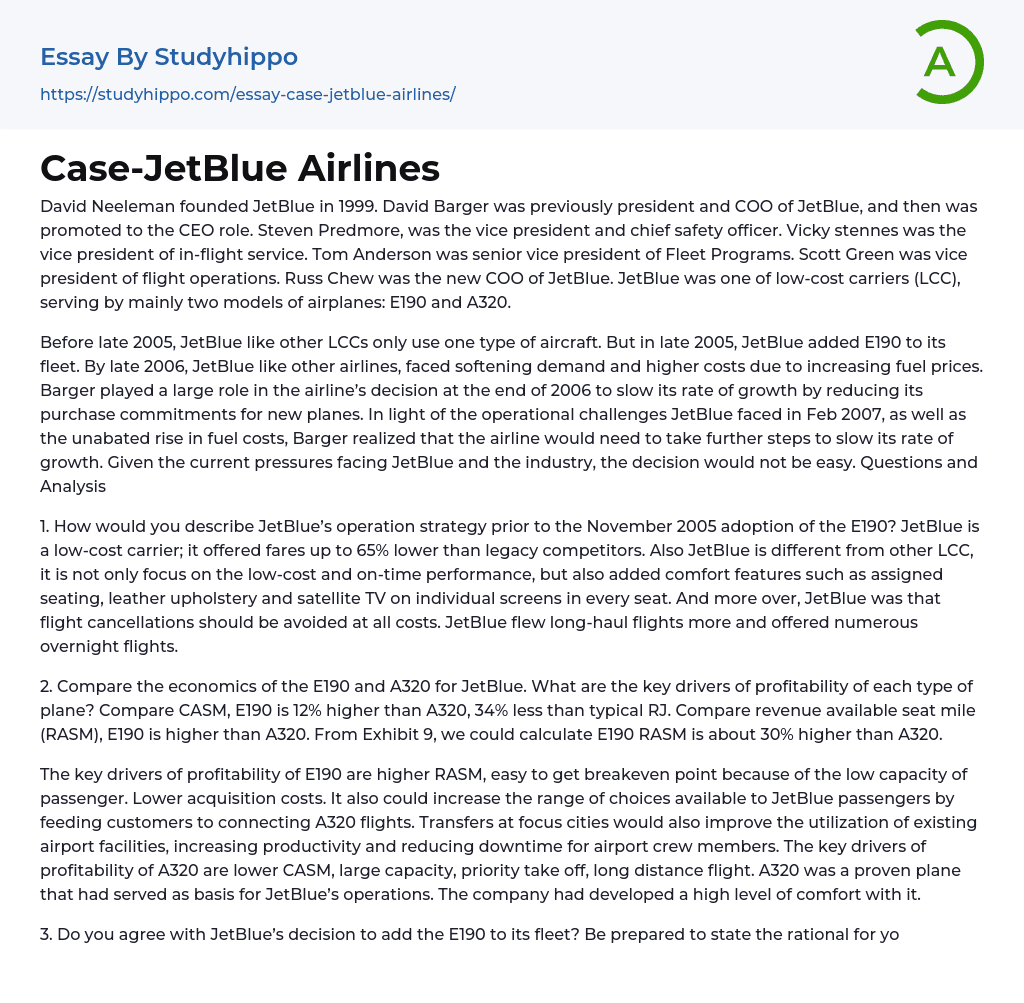David Neeleman founded JetBlue in 1999. David Barger was previously president and COO of JetBlue, and then was promoted to the CEO role. Steven Predmore, was the vice president and chief safety officer. Vicky stennes was the vice president of in-flight service. Tom Anderson was senior vice president of Fleet Programs. Scott Green was vice president of flight operations. Russ Chew was the new COO of JetBlue. JetBlue was one of low-cost carriers (LCC), serving by mainly two models of airplanes: E190 and A320.
Before late 2005, JetBlue like other LCCs only use one type of aircraft. But in late 2005, JetBlue added E190 to its fleet. By late 2006, JetBlue like other airlines, faced softening demand and higher costs due to increasing fuel prices. Barger played a large role in the airline’s decision at the end of 2006
...to slow its rate of growth by reducing its purchase commitments for new planes. In light of the operational challenges JetBlue faced in Feb 2007, as well as the unabated rise in fuel costs, Barger realized that the airline would need to take further steps to slow its rate of growth. Given the current pressures facing JetBlue and the industry, the decision would not be easy. Questions and Analysis
1. How would you describe JetBlue’s operation strategy prior to the November 2005 adoption of the E190? JetBlue is a low-cost carrier; it offered fares up to 65% lower than legacy competitors. Also JetBlue is different from other LCC, it is not only focus on the low-cost and on-time performance, but also added comfort features such as assigned seating, leather upholstery and satellite TV on individual screens in every
seat. And more over, JetBlue was that flight cancellations should be avoided at all costs. JetBlue flew long-haul flights more and offered numerous overnight flights.
2. Compare the economics of the E190 and A320 for JetBlue. What are the key drivers of profitability of each type of plane? Compare CASM, E190 is 12% higher than A320, 34% less than typical RJ. Compare revenue available seat mile (RASM), E190 is higher than A320. From Exhibit 9, we could calculate E190 RASM is about 30% higher than A320.
The key drivers of profitability of E190 are higher RASM, easy to get breakeven point because of the low capacity of passenger. Lower acquisition costs. It also could increase the range of choices available to JetBlue passengers by feeding customers to connecting A320 flights. Transfers at focus cities would also improve the utilization of existing airport facilities, increasing productivity and reducing downtime for airport crew members. The key drivers of profitability of A320 are lower CASM, large capacity, priority take off, long distance flight. A320 was a proven plane that had served as basis for JetBlue’s operations. The company had developed a high level of comfort with it.
3. Do you agree with JetBlue’s decision to add the E190 to its fleet? Be prepared to state the rational for your decision. Yes, I agree. The E190 increased the range of choices available to JetBlue passengers by feeding customers to connecting A320 flights. And also A320s could feed into E190 flights as well, resulting in higher loads and improved economics for JetBlue.
Transfers at focus cities would also improve the utilization of existing airport facilities, increasing productivity and reducing downtime for airport crew members. This
synergy between the E190 and A320 enabled JetBlue to run E190s at an average daily utilization of 10 to 11 hours a day, significantly more than average of 8 hours per day for RJs. And also because the number of passengers required for a flight to meet the typical “breakeven” load of 75% to 80% was much lower on the E190 than the A320, E190 made it easier for JetBlue to introduce service in new markets.
4. How should JetBlue slow down the growth of its fleet? Should it cut growth in A320 capacity, E190 capacity, or both? JetBlue slow down the growth of A320s from 17 to 12 for both 2007 and 2008, for E190s slowdown from 18 to 10. Meanwhile JetBlue slow the annual rate of growth in ASMs for the airline from 18-20% to 14-17%. Obviously JetBlue should cut growth for both A320 and E190. Because E190 as a unique plane that could be used as an engine for future growth, and A320 was a proven aircraft around which JetBlue had standardized its training and operating activities. In addition, E190 and A320 could inter-activate utilization. So it is not fit to cut growth in only A320 capacity or E190 capacity.
- Cars essays
- Bicycle essays
- Rms Titanic essays
- Renault essays
- Truck essays
- chrysler essays
- The city essays
- Racing essays
- Aviation essays
- Emergency Management essays
- Health Insurance essays
- Insurance essays
- Life Insurance essays
- Public Transport essays
- Transportation essays
- Easyjet essays
- Low-Cost Carrier essays
- Adaptation essays
- Adventure essays
- Adversity essays
- Aging essays
- Alcohol essays
- Barbie Doll essays
- Beauty essays
- Care essays
- Carpe diem essays
- Change essays
- Chess essays
- Chicken essays
- Choices essays
- Contrast essays
- Crops essays
- Development essays
- Dream essays
- Evil essays
- Experience essays
- Family essays
- Farm essays
- Fire essays
- First Love essays
- Focus essays
- Greed essays
- Hero essays
- Holiday essays
- House essays
- Housing essays
- Humility essays
- Humor essays
- Hypocrisy essays
- Integrity essays




